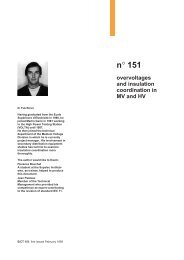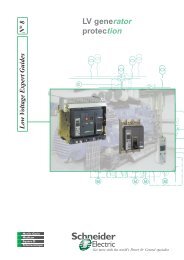sepam 20 user manual - Schneider Electric
sepam 20 user manual - Schneider Electric
sepam 20 user manual - Schneider Electric
You also want an ePaper? Increase the reach of your titles
YUMPU automatically turns print PDFs into web optimized ePapers that Google loves.
DE80321<br />
Modbus communication Time-tagging of events<br />
Architecture for "external synchronization" via a logic input.<br />
PCRED301005EN - 06/<strong>20</strong>08<br />
Synchronization (cont’d)<br />
External synchronization via a logic input mode<br />
Sepam can be synchronized externally by means of a logic input (I21) (the MES114<br />
module is required).<br />
The synchronisation pulse is determined by the rising edge of the logic input.<br />
Sepam can adapt to all synchronization pulse periods from 10 to 60 s, by 10 s steps.<br />
The shorter the synchronization period, the more accurate time-tagging of status<br />
changes is.<br />
The first time frame is used to initialize Sepam with the absolute date and time (the<br />
following frames are used for the detection of any time changes).<br />
The synchronization pulse is used to reset Sepam’s internal clock. In the initialization<br />
phase, when Sepam is in "non-synchronous" mode, resetting is allowed, within an<br />
amplitude of ±4 seconds.<br />
In the initialization phase, the resetting process (switching of Sepam into<br />
"synchronous" mode) is based on a measurement of the difference between<br />
Sepam’s current time and the nearest ten second period. This measurement is taken<br />
at the time of the receipt of the synchronization pulse following the initialization time<br />
frame. Resetting is allowed if the difference is less than or equal to 4 seconds, in<br />
which case Sepam switches to "synchronous" mode.<br />
As of that time (after the switching to "synchronous" mode), the resetting process is<br />
based on the measurement of a difference (between Sepam’s current time and the<br />
nearest ten second period at the time of the receipt of a synchronization pulse),<br />
which is adapted to match the synchronization pulse period.<br />
The synchronization pulse period is determined automatically by Sepam when<br />
it is energized, based on the first two pulses received: the synchronization<br />
pulse must therefore be operational before Sepam is energized.<br />
The synchronization function only operates after Sepam has been time-set, i.e.<br />
after the disappearance of the "incorrect time" event.<br />
Any time changes greater than ±4 seconds in amplitude are made by sending a new<br />
time frame. The switch from summer time to winter time (and vice versa) is made in<br />
this way as well.<br />
There is a temporary loss of synchronism when the time is changed.<br />
The external synchronization mode requires additional equipment, a<br />
"synchronization clock " to generate a precise periodic synchronization time pulse.<br />
If Sepam is in "correct time and synchronous" status, and if the difference in<br />
synchronism between the nearest ten second period and the receipt of the<br />
synchronization pulse is greater than the synchronism error for 2 consecutive<br />
synchronization pulses, it switches into non-synchronous status and generates the<br />
appearance of a "not synchronous" event.<br />
Likewise, if Sepam is in "correct time and synchronous" status, the failure to receive<br />
a synchronization pulse for <strong>20</strong>0 seconds generates the appearance of a "not<br />
synchronous" event.<br />
5/21<br />
5

















